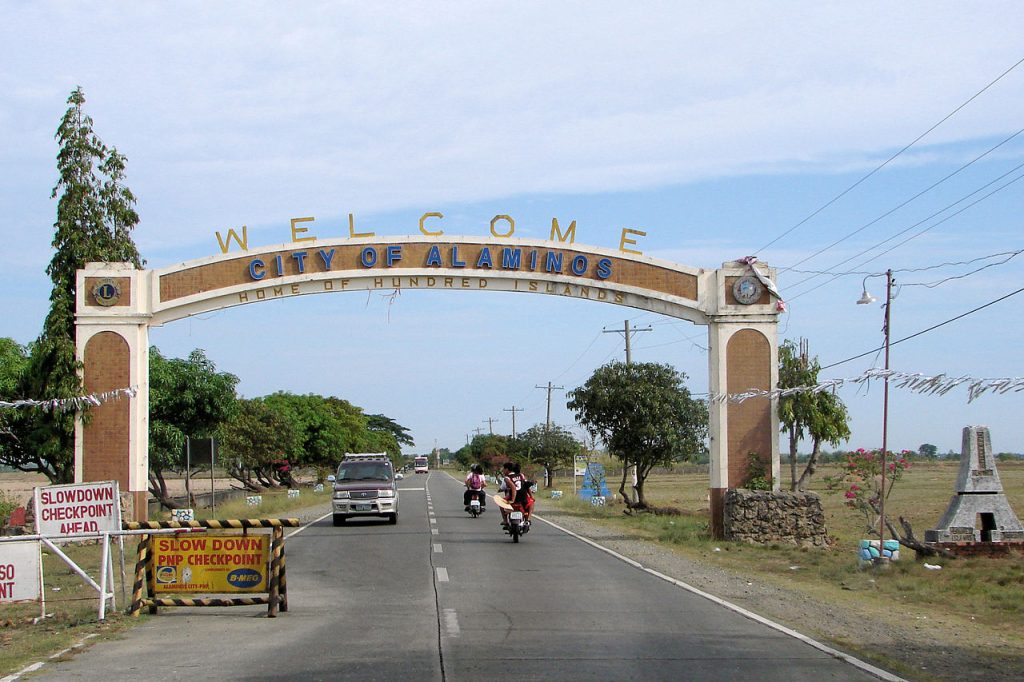
Welcome sign by P199
Alaminos City, Pangasinan: The Heart of the Hundred Islands
Welcome to the component city of Alaminos, Pangasinan—a coastal gem in the Ilocos region famous as the gateway to the breathtaking Hundred Islands National Park. With its mix of natural beauty, rich history, and local culture, Alaminos offers an unforgettable travel experience. This city has 39 barangays, a 2020 population of 99,397 people, and a land area of 164.26 sq. kilometers (63.42 sq. miles).
A Peek into the Past: Rich History & Culture
- Origins & name
From its early days as Casborran in 1737, the settlement evolved into Sarapsap, and was renamed Alaminos in 1872 after Governor-General Juan Alaminos y Vivar. - Cityhood
On March 28, 2001, the municipality officially became the City of Alaminos via Republic Act 9025. - Heritage landmarks
The St. Joseph Cathedral, originally built in 1776 and later elevated in 1985, stands proud in the barangay Población—a Baroque testament to the city’s faith and resilience.
by WanderHacker
Why Alaminos Shines
- Mangrove Eco Parking
The 8-hectare Bued Mangrove Park features a scenic boardwalk and tranquil views of the gulf, a calm contrast before or after island adventures. - Beaches Beyond the Islands
Hidden shores like Tobouan and Bolo Beach offer laid-back sandy retreats for swimming, sunbathing, and watching sunsets. - Hundred Islands National Park
Located off the coast of barangay Lucap is the first national park in the Philippines, this protected archipelago boasts 123 islands at high tide and 124 at low tide across roughly 1,844 hectares of islands—Quezon, Governor’s, Children’s, and Pilgrimage—are developed for visitors, offering snorkeling, kayaking, cliff-jumping, and cave exploring. Established in 1940. Through island hopping you’ll encounter:- Quezon Island: Relax in gazebos, snorkel, helmet dive, kayak, or dine at island pavilions.
- Governor’s Island: Climb 180 steps to its panoramic lookout and ride a 546‑m zipline.
- Children’s Island: Family-friendly sands perfect for kids and gentle paddling.
- Cuenco, Milagrosa, Pilgrimage: Marvel at caves, cliffs, or chance a cliff jump at Imelda Cave.
by Travellingpeoples
Beyond the Islands: Inland Adventures
- Bued Mangrove Eco‑Park
A restored 8‑hectare mangrove sanctuary with a 448‑m boardwalk for bird and bat watching. - Bolo & Tobouan Beaches
Turquoise waters meet fine sand—ideal for sunbathing or swimming in a calm coastal setting.
Tastes of Alaminos: Local Flavors Worth Trying
- Alaminos Longganisa
A garlicky, tangy sausage with vibrant achuete color, celebrated annually in March; usually served in bite‑size links tied with coconut leaf midribs. - Kakanin & seafood delights
From binungey (bamboo-cooked sticky rice) and patupat (sweet rice treats) to fresh bangus (milkfish), kilawing isda (ceviche), grilled prawns, and squid—the city’s food scene is rich and delightful.
Festivals & Local Flair
- Paraw Festival (March): Celebrates maritime roots with paraw (local sailboat) races and vibrant cultural showcases.
- Moro-Moro/Zarzuela & Senakulo: Traditional plays reenacting historical narratives and Holy Week stories.
- Longganisa Festival (3rd week March) & Talaba (Oyster) Festival
- Hundred Islands Festival (May): Enjoy street dancing, seafood fairs, concerts, sports, and heavenly night-time fireworks.
by Mom MayFer
Getting There & Getting Around
- From Manila: A 5‑hr drive via NLEX → SCTEX → Pangasinan.
- From Clark: Approx. 3 hours via SCTEX and Tarlac route.
- Accessible via frequent bus lines like Five Star, Victory Liner, Dagupan Bus, and Philippine Rabbit.
- On-site: Boats from Lucap Wharf; tricycles and the Alaminos Tourism Center facilitate island tours.
Must-Do Activity Guide
| Activity | Details |
| Island Hopping | Rent a bangka from Lucap Wharf and explore caves, beaches, snorkel spots, and Monkey Island. |
| Cliff Diving at Marcos Island | Brave the 20-foot cliff jump into Imelda’s Cave—optional entry via stairs . |
| Mangrove Strolls | Wander the elevated boardwalk in Bued Mangrove Park for marine life spotting and peaceful views . |
| Beach Time | Lounge or kayak at Bolo and Tobouan Beaches—ideal for relaxation . |
| Cathedral Visit | Tour St. Joseph’s Cathedral for its baroque architecture and centuries of history . |
| Tastefest & Souvenirs | Sample longganisa in the morning, shop for shell crafts, mugs, shirts, and more at Lucap souvenir stalls . |
Responsible & Sustainable Travel
Alaminos enforces bans on alcohol on the islands, designated smoking zones, and frequent clean-up efforts led by both LGU and NGOs. Enjoy the mangrove plantings and eco-conscious tourism efforts spearheaded locally.
Where to Stay
Lodging options span from island cottages to city resorts:
- Maxine by the Sea: beachfront lodge with fresh seafood—great for staying close to island adventures.
- Guesthouses & inns dot Lucap and Barangay Telbang: Bamboo Paraiso, Nautilus Island View, Empress Inn, Danna’s, and U & Me Apartelle.
Getting There & Travel Tips
- How to Go: It’s a 5–6 hour bus ride from Manila (via Victory Liner/Five Star), or ~4 hour drive via SCTEX to Alaminos.
- Travel Essentials: Bring swimwear, sunscreen, water shoes (for rocky islands), insect repellent, and weather‑appropriate clothes.
- Best Time to Visit: March to May (summer) is ideal, especially around festival season.
- Local Etiquette: Locals are warm; brushing up on basic Tagalog or Ilocano phrases is appreciated.
Final Thoughts
Alaminos City effortlessly combines history, tradition, cuisine, and natural marvels. Whether you’re exploring ancient caves, savoring local longganisa, relaxing at sun-kissed beaches, or immersing yourself in festivals, Alaminos offers an enriching and vibrant escape.
Pack your bags, chart your boat route to the Hundred Islands, and get ready to fall in love with the magic of Alaminos!
by Biyahe ni Jerdie